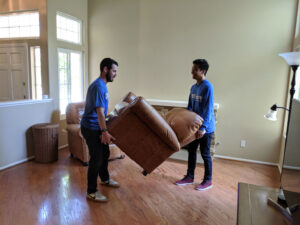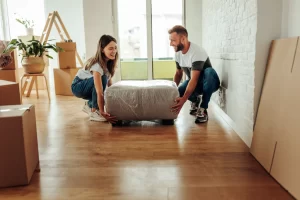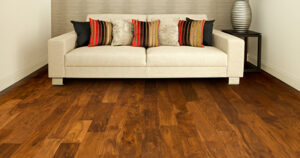We know how frustrating it can be to see your beautiful floors damaged by furniture. But fear not! In this article, we’ll show you the best techniques to protect your floors and keep them looking pristine.
From understanding different floor types to using furniture pads and proper lifting techniques, we’ve got you covered. Say goodbye to scratches and scuffs with our expert tips on preventing damage.

So let’s dive in and learn how to give your floors the care they deserve!
Key Takeaways of How to Protect Your Floors From Furniture
- Use floor protection methods like felt pads or glides, area rugs, and coasters
- Consider the specific needs of different flooring materials for proper protection
- Attach furniture pads or felt glides to chair legs, table feet, or heavy furniture pieces
- Use proper lifting and moving techniques, such as using furniture sliders and padding during relocation
Types of Floor Damage
There are several types of floor damage that can occur from furniture. It is important to be aware of these damages so that we can take proactive steps to protect our floors.
Common causes of floor damage include scratches, dents, and stains. Scratches can be caused by dragging furniture across the floor without any protection or by sharp edges on the furniture itself. Dents may occur when heavy furniture is placed directly on the floor without any cushioning. Stains can be caused by spills or leaks from liquids or oils present in certain furniture materials.

To prevent such damages, it is essential to use floor protection methods like felt pads or glides under the legs of furniture, area rugs or mats in high traffic areas, and coasters for drinks placed on wood surfaces.
Understanding Floor Types
Different floor types require varying levels of maintenance and care. When it comes to choosing the right floor protection, it’s important to understand the different flooring materials and their specific needs. Here are three key factors to consider:
- Hardwood: This classic flooring option adds warmth and elegance to any space but is susceptible to scratches and dents. To protect your hardwood floors, use furniture pads or felt glides on the legs of your furniture.
- Laminate: Known for its durability and affordability, laminate floors can still be damaged by heavy furniture. Invest in rubber or plastic caps for chair legs or consider using area rugs in high-traffic areas.
- Tile: Tile floors are highly resistant to scratches and stains but can crack under excessive weight. Place furniture coasters under heavy pieces to distribute the weight evenly and prevent damage.
Furniture Pads and Protectors
When it comes to maintaining and caring for diverse types of flooring, using furniture pads or felt glides is essential. These small accessories provide the necessary protection to prevent scratches, dents, and damage caused by moving furniture.
Furniture pads are typically made of durable materials such as felt or rubber and can easily be attached to the bottom of chair legs, table feet, or other heavy furniture pieces. They create a buffer between your floor and the furniture, reducing friction and preventing unsightly marks or scuffs.

Felt glides are particularly effective on hard surfaces like hardwood or tile floors, while rubber furniture feet work well on carpeted areas.
Proper Lifting and Moving Techniques
When it comes to lifting and moving furniture, we need to be mindful of our body posture to avoid strain and injury. By maintaining correct body posture, such as keeping our back straight and using our legs to lift, we can prevent unnecessary back pain.
Additionally, using furniture sliders can help us easily move heavy items without causing damage to the floors.
And finally, protecting both the furniture and the floors with padding can ensure a safe and smooth relocation process.
Correct Body Posture
To protect your floors from furniture, it’s important to maintain correct body posture while lifting and moving heavy items. This not only prevents back injuries but also minimizes the risk of accidentally damaging your floors. Here are three key points to remember:
- Use ergonomic chairs: Investing in an ergonomic chair for your workspace can significantly improve your sitting posture. These chairs provide proper lumbar support and encourage a neutral spine position, reducing strain on both your back and floors.
- Consider standing desks: Standing desks promote better posture by allowing you to alternate between sitting and standing throughout the day. By frequently changing positions, you can alleviate pressure on specific areas and distribute weight evenly, safeguarding your floors from unnecessary stress.
- Take breaks and stretch: Regular breaks during prolonged periods of sitting or standing can help prevent muscle stiffness and fatigue. Incorporate stretching exercises into these breaks to keep your muscles flexible and maintain good posture.
By following these recommendations for correct body posture, you’ll be taking proactive measures towards protecting both yourself and your floors from potential damage caused by heavy furniture.
Now that we understand the importance of maintaining correct body posture while lifting heavy items, let’s move on to discussing another effective method – using furniture sliders.
Use Furniture Sliders
Using furniture sliders is an efficient way to easily move heavy items without causing damage to your floors. These small, flat discs or pads are designed to be placed under the legs or corners of furniture, allowing them to glide smoothly across various surfaces. Furniture glides come in different materials such as plastic, rubber, or felt, each offering specific benefits for different types of flooring. Felt glides are ideal for hardwood or tile floors as they provide a soft and smooth surface that won’t scratch or scuff. Rubber glides work well on carpeted floors, providing stability and preventing furniture from sinking into the carpet fibers. By using furniture sliders with proper padding, you can ensure the longevity of both your furniture and your floors while also providing carpet protection.
| Material | Floor Type |
|---|---|
| Plastic | Hardwood |
| Felt | Tile |
| Rubber | Carpet |
| Metal | Laminate |
Protect With Padding
By adding padding, you can ensure that your hardwood or tile floors stay in good condition when moving heavy furniture. Here are three effective protection methods for floor damage prevention:
- Felt pads: Placing adhesive felt pads on the bottom of your furniture legs provides a soft barrier between the furniture and the floor. These pads are easy to install and help prevent scratches and scuffs.
- Area rugs: Using area rugs strategically placed under heavy furniture can provide an extra layer of protection for your floors. The rug acts as a buffer, absorbing any impact or friction caused by moving the furniture.
- Furniture blankets: When moving large pieces of furniture, wrapping them in thick blankets or padding will protect both the furniture itself and your flooring from any potential dings or scratches during transportation.
Using these protection methods will give you peace of mind knowing that your floors are safeguarded against damage while moving heavy items around your home.
Preventing Scratches and Scuffs
When it comes to preventing scratches and scuffs on your floors, there are a few key points to keep in mind.
First, consider using felt furniture pads on the bottom of your chairs, tables, and other heavy pieces of furniture. These pads provide a soft barrier between the furniture and the floor, reducing the risk of damage.
Additionally, floor protectors and glides can be helpful in preventing scratches caused by sliding or dragging furniture across the floor.
Felt Furniture Pads
To keep your floors safe from scratches, make sure to attach felt furniture pads to the bottom of your chairs and tables. This simple step can go a long way in preventing damage to your beautiful floors.
Here are three reasons why felt furniture pads are essential for floor protection:
- Scratch Prevention: Felt pads act as a buffer between your furniture legs and the floor surface, preventing scratches and scuffs that can occur from constant movement.
- Noise Reduction: Not only do felt pads protect your floors, but they also help reduce noise caused by sliding or dragging chairs and tables.
- Easy Installation: Attaching felt furniture pads is quick and hassle-free. Simply peel off the adhesive backing and firmly press them onto the bottoms of your furniture legs.
Floor Protectors and Glides
Floor protectors and glides are essential for preventing damage to your beautiful flooring surfaces. Whether you have hardwood, tile, laminate, or carpeted floors, using floor glides and chair leg protectors can help prolong the life of your floors and keep them looking pristine.

Floor glides are small discs that attach to the bottom of furniture legs, allowing them to glide smoothly across the floor without scratching or scuffing. Chair leg protectors, on the other hand, are caps or pads that fit over chair legs to provide a cushioned barrier between the furniture and the floor. These protectors come in various materials such as felt, rubber, or plastic and are easily attached with adhesive backing or simply slipped onto the legs.
Lift and Don’t Drag
Using floor glides and chair leg protectors will help prevent damage to your flooring surfaces. However, it’s not enough to just have these protective measures in place; you also need to use proper technique when moving furniture.
Here are three key tips for lifting and not dragging furniture:
- Bend at the knees: When lifting heavy objects, it’s important to engage your leg muscles rather than relying solely on your back. By bending at the knees and using your leg strength, you can distribute the weight more evenly and reduce strain on your back.
- Keep a straight back: As you lift, make sure to maintain good posture by keeping your back straight. This helps to further minimize the risk of injury and ensures that you’re using proper body mechanics.
- Use assistance if needed: If an item is too heavy or bulky for you to lift alone, don’t hesitate to ask for help or use tools such as dollies or hand trucks. It’s better to be safe than sorry when it comes to protecting both yourself and your floors from potential damage.
Regular Maintenance and Care
Regularly sweeping and mopping your floors will keep them looking clean and well-maintained. Regular cleaning is essential for proper floor maintenance. Dust, dirt, and debris can accumulate on the surface of the floor, causing scratches and dullness over time. By sweeping or vacuuming your floors regularly, you can remove these particles before they have a chance to cause damage.
In addition to regular cleaning, it is important to address spills and stains promptly. Liquids can seep into the cracks between floorboards or penetrate porous surfaces, leading to discoloration or warping. To prevent this, clean up spills immediately using a damp cloth or mop.
Frequently Asked Questions
What Are Some Common Types of Floor Damage Caused by Furniture?
Preventing floor damage is important. We have learned that furniture can cause scratches, dents, and stains on floors. To avoid this, we follow tips for furniture maintenance such as using felt pads and lifting instead of dragging heavy items.
How Do I Determine the Type of Flooring in My Home?
To determine the type of flooring in our home, we can look for visual cues like color and texture, consult home improvement records or professionals, and check for manufacturer labels or markings on the floor.
What Are the Different Types of Furniture Pads and Protectors Available?
There are various types of furniture pads and protectors available, each with their own pros and cons. Different materials like felt, rubber, or silicone can be used to safeguard your floors from scratches and dents caused by furniture.
Are There Specific Techniques for Lifting and Moving Heavy Furniture Without Damaging the Floor?
To minimize floor damage while moving heavy furniture, we can employ specific techniques. Using furniture sliders effectively is one such technique that allows for smooth and easy movement without causing scratches or dents on the floor.
Are There Any Additional Steps I Can Take to Prevent Scratches and Scuffs on My Floors?
To prevent scratches and scuffs on our floors, we can take additional steps for floor protection and maintenance. By using furniture pads or felt protectors, regularly cleaning the floors, and avoiding dragging heavy furniture, we can keep our floors looking pristine.
Conclusion
In conclusion, it’s essential to protect our floors from furniture damage to ensure their longevity and beauty. By using furniture pads and protectors, practicing proper lifting techniques, and regularly maintaining and caring for our floors, we can prevent scratches, scuffs, and other types of damage.
Remember, a stitch in time saves nine – taking preventive measures now will save us from costly repairs in the future. So let’s be proactive in safeguarding our floors and enjoy their pristine condition for years to come.




